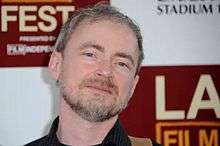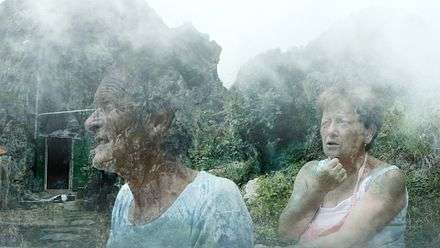Simone Rapisarda Casanova
| Simone Rapisarda Casanova | |
|---|---|
 Simone Rapisarda Casanova at the LA Film Festival in 2012 | |
| Born |
July 26, 1970 Catania, Italy |
| Nationality | Italian |
| Citizenship | Canadian |
| Occupation | Filmmaker |
| Known for | Winner of the Best Emerging Director award, Locarno Film Festival 2014, Switzerland |
| Notable work | The Strawberry Tree (2011), The Creation of Meaning (2014) |
Simone Rapisarda Casanova is an Italian experimental filmmaker currently living in Canada. In 2014 he won the Leopard for Best Emerging Director at the Locarno International Film Festival.
Life
Rapisarda Casanova was born in Sicily, Italy. He developed an interest in photography and cinema while studying Computer Science at the University of Pisa. Soon after moving to Canada in 2000, he abandoned his career in the software industry to devote himself to studying film, first in Montreal and later in Toronto.[1]
He is both an active filmmaker and a teacher (York University, Toronto, Canada; Wilfrid Laurier University, Waterloo, Canada; Ciné Institute, Jacmel, Haiti).[2] He is currently an assistant professor at Simon Fraser University's School for the Contemporary Arts, Vancouver, Canada.[3]
Filmography
Blending documentary and fiction, Rapisarda Casanova’s experimental films are the result of a process-driven approach in which the filmmaker, eschewing screenwriting and production-planning, personally tackles all aspects of preproduction, production and postproduction.[2] His style is marked by an elliptical approach to storytelling, long takes, fixed camera positions, and the choice of non-actors who improvise on a loose outline. The filmmaker only shoots one take for each scene and, at a later stage, chooses and assembles only what seems to evoke the most intimate essence of characters and places.[4] Metacinematic narratives, diegetic soundscapes, low-angle shots and the extensive use of wide-angle and ultra wide-angle lenses are other trademarks of his style.[1]
El árbol de las fresas (The Strawberry Tree)
(Canada/Cuba/Italy, 2011, 71 min) The first feature-length film by the author is an experimental ethnography that captures the last days of the village of Juan Antonio, Cuba, shortly before hurricane Ike wiped it out.[4][5][6][7] The film was included in Film Comment’s list of the “Fifty Best Undistributed Films of 2012.”
La creazione di significato (The Creation of Meaning)

(Italy/Canada, 2014, 90 min) An aging but tenacious Tuscan shepherd, Pacifico Pieruccioni, is forced by the economic crisis to give up the house and land where his parents had fought in the Resistance against the German Army during World War II. Oddly enough, the prospective buyer is a young German. The shepherd and the prospective buyer start a conversation about history and present-day Italy.[8][9][10] The film has won the Best Emerging Director award at the Locarno International Film Festival in 2014.
See also
References
- 1 2 "Discovering the Spiritus Loci: Simone Rapisarda Casanova on The Creation of Meaning". Filmmaker Magazine. Retrieved 12 May 2016.
- 1 2 "Pacifico's Heights: Simone Rapisarda Casanova on The Creation of Meaning". Cinemascope. 2012. Retrieved 12 May 2016.
- ↑ "School for the Contemporary Arts Faculty". Simon Fraser University. Retrieved 28 Oct 2016.
- 1 2 "A tree that's no longer there: An interview with filmmaker Simone Rapisarda Casanova". Austin Vida. 2012. Retrieved 12 May 2016.
- ↑ "2012 Ann Arbor Film Festival". Academic Hack. Retrieved 12 May 2016.
- ↑ "The Strawberry Tree: LAFF review". The Hollywood Reporter. Retrieved 12 May 2016.
- ↑ "Images Conscious". Art Forum. Retrieved 12 May 2016.
- ↑ "Shepherd Doc 'The Creation of Meaning' Finds Majesty in a Vanishing Way of Life". The Village Voice. Retrieved 12 May 2016.
- ↑ "Film Review: 'The Creation of Meaning'". Variety. Retrieved 12 May 2016.
- ↑ "Review: 'The Creation of Meaning' Views an Economically Torn Italy in Echoes of Earlier Days". The New York Times. 16 December 2015. Retrieved 12 May 2016.